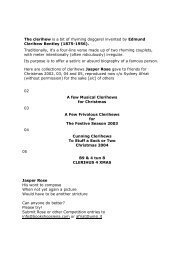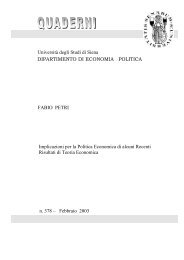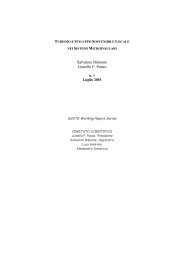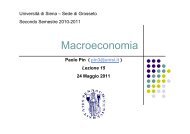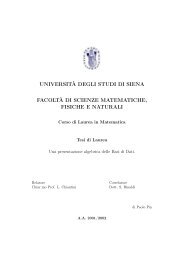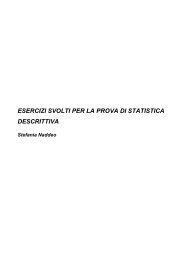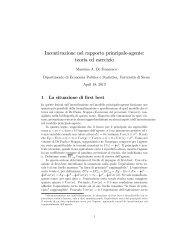Appunti delle lezioni di istituzioni di matematica attuariale per le ...
Appunti delle lezioni di istituzioni di matematica attuariale per le ...
Appunti delle lezioni di istituzioni di matematica attuariale per le ...
You also want an ePaper? Increase the reach of your titles
YUMPU automatically turns print PDFs into web optimized ePapers that Google loves.
Confrontando la (193) con la (194) si ottiene che<br />
e quin<strong>di</strong> che<br />
La <strong>di</strong>fferenza<br />
tVx Dt<br />
=<br />
1 + i 1 + It<br />
1 + It<br />
Dt = tVx<br />
1 + i = <br />
tVx<br />
1 + It − i<br />
1 + i<br />
It − i<br />
∆t = Dt − tVx = tVx<br />
1 + i<br />
<br />
. (195)<br />
(196)<br />
è il surplus (in senso algebrico) <strong>di</strong> valore degli attivi rispetto alla riserva che l’assicuratore<br />
deve coprire. Il segno <strong>di</strong> ∆t è quello della <strong>di</strong>fferenza It −i: il surplus è positivo se il ren<strong>di</strong>mento<br />
degli attivi ha “battuto” il tasso tecnico, negativo se hanno reso meno del tasso tecnico. Si<br />
tratta <strong>per</strong>tanto <strong>di</strong> un uti<strong>le</strong> (in senso algebrico) <strong>di</strong> tipo finanziario.<br />
Osservazione 6.2.1. Il surplus (196) è una misura dell’uti<strong>le</strong> finanziario <strong>le</strong>ggermente <strong>di</strong>versa<br />
dalla componente finanziaria della scomposizione <strong>di</strong> Homans dall’uti<strong>le</strong> vista nel paragrafo 5.3.<br />
La <strong>di</strong>fferenza è pricipalmente dovuta al fatto che la (196) esprime l’uti<strong>le</strong> certo in t <strong>di</strong> una<br />
polizza in essere al tempo t; l’uti<strong>le</strong> finanziario in t nel senso della scomposizione <strong>di</strong> Homans<br />
è ottenuto invece <strong>per</strong> un contratto in essere al tempo t − 1 ed è a<strong>le</strong>atorio (come nella (174))<br />
o atteso (come nella (177)).<br />
Si assuma che l’assicuratore voglia retrocedere all’assicurato una parte del surplus (196),<br />
in modo da far partecipare l’assicurato all’uti<strong>le</strong>. Poiché il surplus deriva dal ren<strong>di</strong>mento<br />
<strong>di</strong> gestione It, l’idea è <strong>di</strong> fissare contrattualmente un’aliquota <strong>di</strong> retrocessione (aliquota <strong>di</strong><br />
partecipazione) β ∈ (0, 1] e <strong>di</strong> ripartire il ren<strong>di</strong>mento degli attivi in base a quest’aliquota:<br />
It = βIt + (1 − β)It .<br />
La componente βIt è il ren<strong>di</strong>mento retrocesso all’assicurato, (1−β)It è il ren<strong>di</strong>mento trattenuto.<br />
La scomposizione del ren<strong>di</strong>mento induce una scomposizione del surplus: l’uti<strong>le</strong> retrocesso<br />
∆retr t si ottiene calcolando la (196) <strong>per</strong> il solo ren<strong>di</strong>mento retrocesso, ciò che rimane del surplus<br />
. In formu<strong>le</strong><br />
è l’uti<strong>le</strong> trattenuto dall’assicuratore ∆ tratt<br />
t<br />
∆ retr<br />
t<br />
∆ tratt<br />
t<br />
βIt − i<br />
= tVx<br />
1 + i<br />
= ∆t − ∆ retr<br />
t<br />
, (197)<br />
(1 − β)It<br />
= tVx<br />
1 + i<br />
. (198)<br />
Quest’idea non può essere (e nella pratica non viene) applicata in questo modo. Infatti, se<br />
It < i/β, l’uti<strong>le</strong> da retrocedere sarebbe negativo, con prob<strong>le</strong>mi <strong>di</strong> tipo giuri<strong>di</strong>co e anche<br />
commercia<strong>le</strong>. Per questo motivo viene aggiunta la con<strong>di</strong>zione che l’assicurato partecipi sì<br />
all’uti<strong>le</strong>, ma non al <strong>di</strong>suti<strong>le</strong>, che viene attuata aggiugendo il vincolo che il risultato della<br />
(197) sia non negativo. Le formu<strong>le</strong> <strong>di</strong>ventano quin<strong>di</strong><br />
∆ retr<br />
t<br />
∆ tratt<br />
t<br />
<br />
βIt − i<br />
= max tVx<br />
= ∆t − ∆ retr<br />
t<br />
1 + i<br />
.<br />
Introducendo il tasso <strong>di</strong> rivalutazione<br />
<br />
βIt − i<br />
ρt = max , 0 =<br />
1 + i<br />
max (βIt , i) − i<br />
1 + i<br />
<br />
, 0<br />
,<br />
= 1 + max (βIt , i)<br />
1 + i<br />
− 1 (199)<br />
c○ C. Pacati 2005, <strong>Appunti</strong> IMAAV, sezione 6 (v. 26/12/2005) pag. 40



